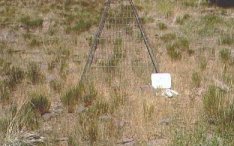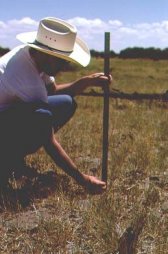Grazing Patterns
Elk and cattle on the V Bar V
The controversy over multiple use of rangelands in Arizona often focuses
on whether or not cattle grazing interferes with wildlife grazing, particularly
elk. What the debate lacks is reliable data to show exactly how cattle
and elk grazing patterns do or do not overlap.
 A
study now in progress on the V Bar V Ranch, a University of Arizona
research facility in northern Arizona, is designed to provide some of
this missing information. Lacey Halstead, a graduate student in the
School of Renewable Natural Resources in the UA College of Agriculture,
is measuring forage use in an existing grazing allotment to determine
the feeding patterns of both cattle and elk. A
study now in progress on the V Bar V Ranch, a University of Arizona
research facility in northern Arizona, is designed to provide some of
this missing information. Lacey Halstead, a graduate student in the
School of Renewable Natural Resources in the UA College of Agriculture,
is measuring forage use in an existing grazing allotment to determine
the feeding patterns of both cattle and elk.
 The
study site, characteristic of other ranches at this elevation, is located
in the Cedar Flats portion of the ranch, at an altitude of 5500-6000
feet. This part of the ranch has six pastures; Halstead is monitoring
four of them, about 600 acres. The University of Arizona is authorized
by the U.S. Forest Service (USFS) to graze up to 550 head of cattle
on the allotment (see The Study Area). The
study site, characteristic of other ranches at this elevation, is located
in the Cedar Flats portion of the ranch, at an altitude of 5500-6000
feet. This part of the ranch has six pastures; Halstead is monitoring
four of them, about 600 acres. The University of Arizona is authorized
by the U.S. Forest Service (USFS) to graze up to 550 head of cattle
on the allotment (see The Study Area).
The cattle will graze two of the pastures this year, and the other
two next year. This USFS plan theoretically rests half of the allotment
by attracting elk to pastures recently grazed by cattle, Halstead says.
"The USFS system also aims to promote equitable and sustainable levels
of forage use by cattle, elk, and other wild ungulates, and improve
forage quality by encouraging removal of older growth."
Halstead, who is working with professors Larry Howery, George Ruyle
and Paul Krausman, all from the School of Renewable Natural Resources,
wants to determine how the elk interact with the cattle in this system.
"Does the grazing system encourage elk to use pastures recently grazed
by cattle?" she asks. And does that keep the elk from using the pastures
that have been rested from cattle grazing? Halstead also wants to find
out what effect the grazing system has on relative forage use by cattle
and elk in rested and grazed pastures, and whether the USFS height-weight
technique is as reliable for measuring forage use as another method
called the paired-plot technique.
The two-year study, begun in March of 1997, has three goals:
- to determine relative forage use in pastures scheduled for rest
and for cattle grazing, immediately before cattle enter the
grazed pastures
- to determine relative forage use by cattle and elk after
cattle exit grazed pastures, compared to relative forage use by elk
in rested pastures, and
- to determine total forage use in rested and grazed pastures three
to four months after the cattle have exited the grazed pastures.
Halstead measures relative use by checking the difference in the amount
of forage in caged or protected plots versus unprotected plots. The
paired-plot system involves setting up sturdy metal cages, also called
exclosures, at random intervals across the allotment, and marking off
plots of corresponding size without cages.
"Each pasture has three key areas, with six cages per key area, or
72 in all," Halstead says. "The cages have a base four feet square and
are pyramid-shaped to keep them from getting stepped on or knocked over.
Each time we go out we sample from two cages per key area by pulling
them up to clip the vegetation. The cages are portable and can be moved
from year to year. We also sample from four unprotected plots per key
area."
Along with the paired plots, Halstead is measuring height-weight relationships
of grasses along transects, where she checks the height of plants along
a premeasured, staked line, and clips some of the grass to weigh it.
She uses the grass weights to make a height-weight relationship gauge
that translates heights of grazed plants into percent weight removed
and then to percent utilization. She's comparing the two monitoring
techniques using western wheatgrass, a key species in the area as an
indicator of forage use.
"The context of this study is that these federal land grazing permits
are being managed with a lot of resources in mind, not just livestock
management," Ruyle says. "You need to have all these other concerns
for wildlife in your grazing plan. The specific issue in this study
is the elk. The grazing system itself is planned so that cows are in
pastures a short period of time. It's aimed at fairly light utilization,
with grazing periods as short as a few days all year long, then no grazing
for months."
Ruyle adds that the data Halstead is collecting will be important
not just for elk management but also for the whole multi-resource scheme.
Besides elk, other ungulates that graze in the area include pronghorn,
mule deer, and white-tailed deer.
Preliminary results, from data Halstead gathered during the spring
and fall of 1997, indicate that the grazing system may be working differently
than it was originally intended.
"We're finding that the elk are grazing where the cattle are not,"
Halstead notes. She thinks timing may make a difference. "This grazing
system is designed to attract elk to the pasture after the cattle are
there. In the winter, it does that. But in the spring they're on the
opposite side of where the cattle are. They're where the cattle were
last year. There are reasons for that--topography is one, the amount
of tree cover is another. We have more tree cover, which the elk prefer,
on the pastures not grazed this year by cattle."
The researchers found that levels of utilization in the pastures were
light, Ruyle says. The study has another year to go, and it may help
the USFS with its original goal of designing a grazing system where
the cattle and elk both benefit.
"Hopefully the agencies will be able to use this data to adjust grazing
management in the future," Halstead says. "You can't really herd elk
around but you might be able to manage elk grazing by managing cattle,
and that's a really important thing to know."
The Study Area
 The
V Bar V Ranch and its associated Walker Basin allotment are located
in the Beaver Creek and Long Valley Ranger Districts of the Coconino
National Forest. The grazing allotment is divided into two main portions
running west to east, with three seasonal grazing divisions, (i.e.,
winter, transitional and summer) in each portion. Each year, the cattle
are moved up the elevational gradient through pastures on either the
north or south half of the allotment during the growing season and then
moved down the elevational gradient on the same half during the dormant
season. The other half of the allotment is rested the entire year. Within
the grazed half of the allotment, cattle are moved among pastures about
every 10-14 days to promote uniform grazing on current growth and to
prevent cattle grazing on regrowth. The
V Bar V Ranch and its associated Walker Basin allotment are located
in the Beaver Creek and Long Valley Ranger Districts of the Coconino
National Forest. The grazing allotment is divided into two main portions
running west to east, with three seasonal grazing divisions, (i.e.,
winter, transitional and summer) in each portion. Each year, the cattle
are moved up the elevational gradient through pastures on either the
north or south half of the allotment during the growing season and then
moved down the elevational gradient on the same half during the dormant
season. The other half of the allotment is rested the entire year. Within
the grazed half of the allotment, cattle are moved among pastures about
every 10-14 days to promote uniform grazing on current growth and to
prevent cattle grazing on regrowth.
Article written by Susan McGinley, ECAT, College of
Agriculture
This is part of the 1997 Arizona Experiment Station Research Report
This document is located at
http://ag.arizona.edu/pubs/general/resrpt1997/grazing_patterns.html
Return to Index for 1997 report
Researchers:
Lacey Halstead
School of Renewable Natural Resources
(520) 621-5518
leh@u.arizona.edu
George Ruyle
School of Renewable Natural Resources
(520) 621-1384
gruyle@ag.arizona.edu
|